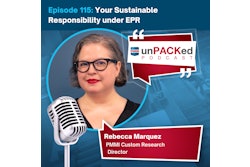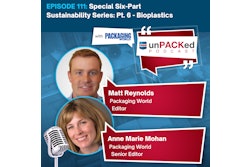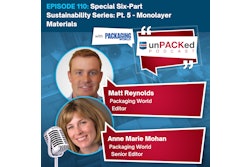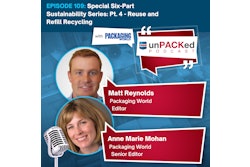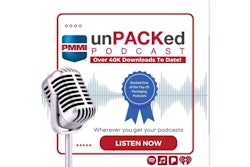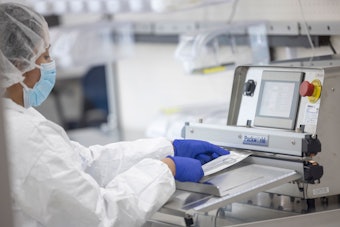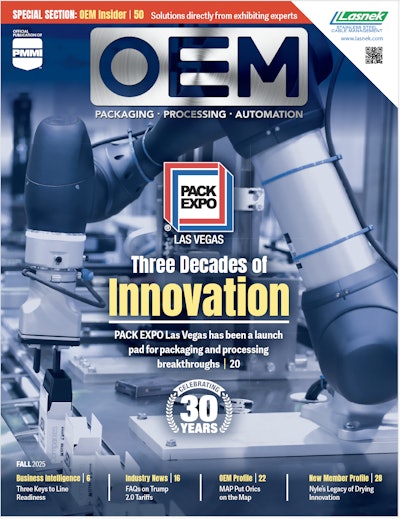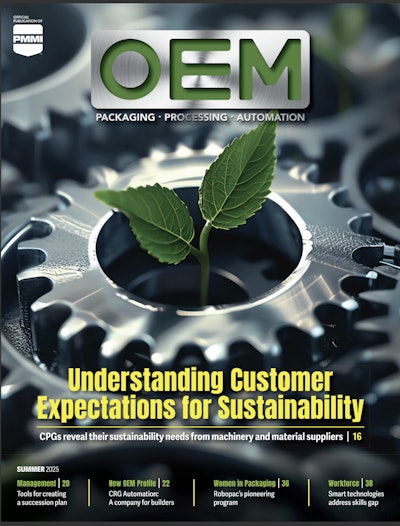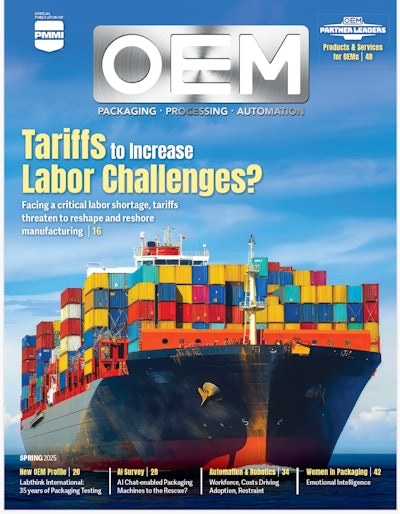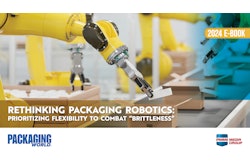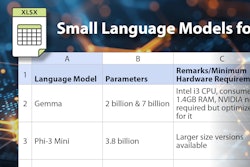PMMI's Director of Custom Research Rebecca Marquez returns to the unPACKed microphone to discuss the findings from her comprehensive collaboration with AMERIPEN: “2023 Packaging Compass: Evaluating Trends in U.S. Packaging Design Over the Next Decade and Implications for the Future of a Circular Packaging System.” In Part One of this Chat, Rebecca takes us through the most important findings from the report. Be on the lookout for Part Two, offering a perspective on how legislation down the road might impact OEMs and CPGs.
To subscribe, rate, review, and find more unPACKED podcast episodes, visit pmmi.org/podcast or find us on Apple Podcasts, Spotify, iHeart Radio, or wherever you listen to your podcasts.
Sean Riley:
So with all the fancy introductions out of the way, welcome back to the podcast, Rebecca Marquez.
Rebecca Marquez:
Hiya, Sean, how are ya?
Sean Riley:
I'm great. Last time you were on the pod, we kind of talked about this great study you guys were doing with AMERIPEN, that was going to kind of give us a compass, I like that word, to sort of navigate the next 10 years, in terms of sustainability. And we got sort of where you guys thought you were. At that point, the research wasn't complete yet, but you had some talking points and some ideas. And I know the flexible packaging, right now, it is kind of the most dominant package type. And you guys touched on it a little bit then.
In terms of sustainability, plastic doesn't have the best reputation, and it never really has. Some of it's unfair, some of it's fair. But now that you guys have kind of wrapped up the research on this great study, is that something that's going to have to change, in terms of flexible packaging use? Are people going to have to use it less? Is there something that the MRFs are going to have to do to get prepared for it? I guess, basically, if you could just give us, now that you're done the study and have come out of it, how is flexible packaging going to have to change? Or are we going to be able to adapt to it?
Rebecca Marquez:
I don't think that it's really going to have to change. We find that usage is strong and is going to continue to grow, at least for the next 10 years or so. And that's not all kinds of flexible packaging. Most of them. We do see definite growth in flexible PCR content, which I think we're going to talk about a little bit later. So I don't know that it really has to change. But definitely, MRFs do need to kind of innovate or do things a little differently, so they can handle these materials effectively. Think of a MRF as just a giant sorting center, where everything comes in in one stream and the machinery in the facility has to sort this all into separate bales. So what happens, a lot of times, is it's difficult for machinery to tell the difference between what is flexible packaging and what is maybe paper.
They're both lightweight. Flexible packaging kind of gets stuck in machinery, which means that people that work at MRFs have to climb in there, clean it out. It's not very safe, it's not very efficient, but I think that we can eventually get our heads wrapped around this and make it just a more effective way of sorting these materials. The other problem though in this is that the value of flexible materials, when you sell it back into a market, is not very high. So when you think of corrugate or aluminum and you think of the dollar figure, that goes per ton for those materials, and I don't even want to quote, because I don't want to misrepresent, but I can tell you that flexible materials, in a bale, is far, far less than the value of those other materials.
So that's also something that we need to think about is what we're going to do with these, at end of life, when we have these, finally, when we get our heads wrapped around the sorting, what are we going to do with these materials when they're all in bales and ready to go into a market? But I wouldn't necessarily say we have to change usage. We just really have to figure out how to manage these at end of life in a better way.
Sean Riley:
So is it safe to say that that's still the old, which has kind of been around for a while, where people would just prefer the easier route of buying virgin material than dealing with the recycled material?
Rebecca Marquez:
In some cases, although when we talk to CPGs in the survey, CPGs are trying to get away from, I should say, heavy usage of virgin material. But that's introduces kind of another set of problems. If you want to get away from using virgin material and you want to rely more on post-consumer recycled material, it's got to have a level of purity, particularly when it comes to contact with food. And so, it's a conundrum. You want to get away, as a business, from using virgin material, or so much of it, and you want to rely more on post-consumer recycled material. But then, in a lot of cases, PCR is not food safe, so it's just a whole different issue.
Sean Riley:
So that was some other questions I was going to ask around PCR. And since we're already kind of halfway there, you kind of explained why all packages can't really go that route, which makes sense in regards to food safety and things like that. Is the machinery an issue when it comes to PCR? Is that something that they can handle it just like they could handle virgin material? Or is that something that also is another holdup?
Rebecca Marquez:
We are working on flexible packaging best practices report right now for transitioning these materials. And I was a complete novice when we started doing that report, but the process of changing materials on packaging machinery is so involved. It could be that some of our OEMs, their equipment might not work as well on these types of materials. Sometimes CPGs are going to require a new type of machinery to work with these materials. Sometimes it's just an adjustment. It's a really involved process. Sometimes you do need a new piece of equipment, and that's just how it is. And there's several reasons why CPGs are transitioning these kinds of materials. Legislation is one of them.
Changing legislation might increase the need for PCR content in your packaging materials. There's that. Sometimes it's a supplier problem. But at the end of the day, yes, sometimes machinery does have a hard time working with these materials. And we found in our survey too, when we talked to CPGs, in the AMERIPEN project, that more than 50% actually said that their equipment was part of the problem in them not being able to achieve their sustainability goals. So it looks like, according to the CPGs, there does need to be some innovation happening in the machinery space.
Sean Riley:
Interesting. And just I'm late to this, and I should have explained this up top, but for the seven people that have never listened to a sustainability podcast before, MRFS are the materials recovery facilities, that, after we throw our stuff into the trash and it gets taken away allegedly in a single stream for recycling, it goes to these materials recovery facilities. And as Rebecca explains so well, people then separate them, so that they can go to their different places. So we were just using the acronym with the hopes that everybody understands what MRFs are at some point, so that we don't have to explain it every time.
Rebecca Marquez:
Sean, have you ever been to a MRF?
Sean Riley:
I've never. Have you?
Rebecca Marquez:
Yes.
Sean Riley:
Is it wild?
Rebecca Marquez:
It's wild. It's crazy. And I think that it's a little bit of a life-changing experience, because as a person who was never at a MRF before, you have no idea of the volume of stuff that comes into one of these facilities. And it's really interesting also, because it is still a manual process for a lot of these MRFs. You do have people that are sorting things, but it's really interesting in that they're also, in some cases, adopting vision systems to pick out materials and sort them mechanically using robotic arms. It's really, really wild to see one of these things.
Sean Riley:
And I would think that that has to be the one of the... There's a series of next steps in this big sustainability push and change. And I have to think the automation of you telling me that someone is picking through them at a facility just doesn't seem very 21st century to me. And I have to think it's just because they could, not get away with it's not the proper term, but now that it's being ramped up a little bit more, I could see vision systems and sensors and automation being involved and making it a much smoother and easier process, which would, then, down the line, make all of these conversations a lot easier to have.
Rebecca Marquez:
For sure. I think that innovation and automation is going to play a really important part in this space. I think that's growing. Right now, we're seeing it grow quite a bit, and we all know that there's employee retention problems. In every industry, it seems like people are changing jobs pretty frequently. There are certain jobs that people just don't want to do. And so, it really does introduce more of an absolute need for automation. They still are manual, in some cases, because we're not at the point yet where a machine can pick out a piece of a flexible pouch over some other kind of material. Eventually, we probably will get there, and that will be amazing. Right now though, we're not at that space yet.
Sean Riley:
Yeah, I bet they could. I just think it's probably so not expensive. It's probably not cost effective or it's going to change the bottom line for the MRFs to bring this stuff in, initially. Long run, the ROI would probably be well worth it. But with automation, that is often not the thing they think of first. It's kind of the upfront cost.
Rebecca Marquez:
Yeah, the cost is going to be a barrier of entry to some of these facilities. And I think you bring up a really important point that some of us tend not to think about is that these MRFs are a business. They are not going to make decisions, unless they can make money doing it, because they are a business. So I think, in some cases, MERFs have the reputation for saving the world and doing the right thing, and it is very altruistic. And there is that, but they're also a business. And it's important to remember that.
Sean Riley:
Always. I guess, on a kind of sidestep, let's circle to a more earth friendly type of package, let's call it, with compostable or compostable packaging. It's been around, it's something that we've seen, and it makes headlines, occasionally. Someone will come out with a compostable package. Is it a viable sustainability option, do you think? Or do it's just something that'll kind of remain, I don't want to call it a niche material, because that's not the proper term, but I can't think of a better one right now? Just something that people will use occasionally for target audiences? Or is it something that you think could really catch on?
Rebecca Marquez:
I personally think it is something that could really catch on, and that's something that our CPGs that we surveyed are really looking to adopt. Compostability came in very high for what they want to pivot to over the next 10 years, and I think it's really going to become more viable as we go on. Not that it's not viable now, it is, but there are just some issues with it. One of the big issues with this is, again, contamination. So it's interesting. Colorado is one of our EPR states. It's one of the four states that recently adopted EPR laws, and they just came out making curbside recovery of compostable materials really strict. And one of the main drivers for that is that it's contamination. So people don't necessarily always know what to put in the compost bin. They have to keep it separate from other things that are not compostable.
And when you don't do that, you have contamination. And that makes it really hard for composting facilities to sell to organic farmers. You can't do it in that case. It makes it just unsellable. So there are some other things that we need to also get our heads wrapped around, when it comes to compostability, but I do think that, eventually, it's going to be more widely available. That's another issue with it. It's not widely available right now, because we just don't have the infrastructure for it in the US. But I do think, eventually, we'll get there, and it will be just another end of life solution for materials.


